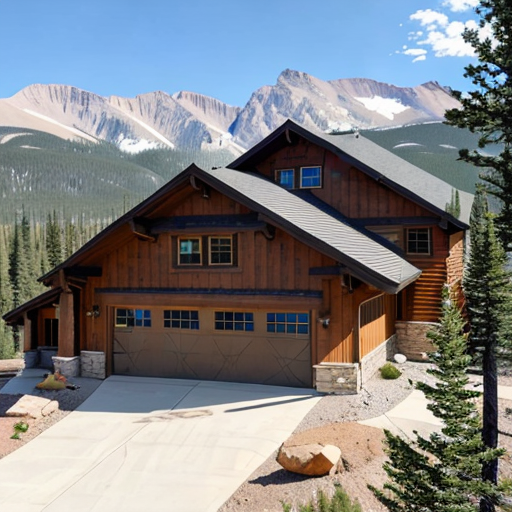No matter how great the builder is, the fact remains that building homes in Colorado presents unique challenges due to the state’s diverse geography, climate, and regulatory environment. The point being.. Experience matters!
Here are the top seven challenges that home builders in Colorado face:
Varying Terrain and Geological Conditions:
Colorado’s diverse geography presents builders with different challenges depending on the region. In mountainous areas, steep slopes and rocky terrain require extensive site preparation, including excavation and retaining walls, to create a stable foundation for the home. For example, building on a mountainside may require specialized engineering techniques, such as helical piers or rock anchors, to ensure structural integrity. In contrast, building on the plains may involve addressing issues related to expansive soils, which can cause foundation movement. Builders must conduct thorough geotechnical assessments and work closely with engineers to design appropriate foundation systems that can withstand specific geological conditions.
Extreme Weather Conditions:
Colorado’s weather can be unpredictable and harsh, with heavy snowfall, strong winds, and severe hailstorms. Homebuilders must consider these factors during the design and construction phases.

Colorado Home Builders need to have special skills!
For instance, roofs should be designed to handle heavy snow loads, and materials with high wind resistance should be used to prevent damage. Additionally, builders must implement proper insulation and weatherproofing techniques to ensure energy efficiency and protect homes from extreme temperature fluctuations. For example, using insulated concrete forms (ICFs) or energy-efficient windows and doors can help homes withstand Colorado’s weather conditions.
Water Management:
Colorado’s semi-arid climate and mountainous terrain pose challenges for managing water resources during home construction. Builders must comply with regulations related to water usage, runoff, and drainage to minimize environmental impacts. For instance, implementing erosion control measures, such as silt fences and sediment basins, is necessary to prevent soil erosion during construction. Builders may also need to incorporate stormwater management systems, such as rainwater harvesting or permeable pavement, to mitigate the impact of runoff on local water sources and comply with water management policies.
Energy Efficiency and Sustainability:
Colorado places a strong emphasis on energy efficiency and sustainable building practices. Builders must meet stringent energy codes and integrate eco-friendly features into their projects. For example, incorporating solar panels, energy-efficient appliances, and advanced insulation systems can help homes achieve higher energy performance ratings. However, balancing these requirements with cost considerations can be challenging. Builders must carefully evaluate the upfront costs and long-term benefits of sustainable features to ensure they align with the target market and budget constraints.
Building Codes and Permitting:
Colorado has specific building codes and regulations that vary across different jurisdictions. Navigating the permitting process and ensuring compliance with local building departments can be time-consuming and complex. Builders must stay updated on evolving codes, submit comprehensive and accurate permit applications, and address any potential issues or modifications required by building officials. Delays in the permitting process can impact project timelines and budgets, so builders must establish good relationships with local authorities and maintain clear communication throughout the construction process.
Labor and Material Costs:
Like many regions, Colorado has experienced rising labor and material costs in recent years. Finding skilled labor can be a challenge, particularly during periods of high demand in the construction industry. Builders must carefully manage labor resources, ensure efficient scheduling, and foster relationships with reliable subcontractors. Moreover, fluctuations in material prices, such as lumber or steel, can significantly impact project budgets. Builders must maintain strong supplier relationships, explore alternative materials when appropriate, and monitor market trends to mitigate cost overruns.
Community and Neighborhood Requirements:
Many communities in Colorado have specific architectural design guidelines, neighborhood covenants, and homeowner associations that impose requirements on home construction. Builders must navigate these regulations to ensure compliance and achieve a harmonious integration of new homes within the neighborhood. This may involve collaborating with community stakeholders, submitting design proposals for approval, and incorporating specific architectural elements or materials. Adhering to these requirements is essential for maintaining the aesthetic integrity of the neighborhood and satisfying the expectations of potential homebuyers.
By recognizing and addressing these challenges, home builders in Colorado can overcome these challenges and successfully construct homes that meet the needs and expectations of homeowners. By recognizing and addressing these challenges, home builders in Colorado can implement effective strategies to overcome them and successfully construct homes that meet the needs and expectations of homeowners.
Implementing advanced construction techniques: Home builders can employ advanced construction techniques to tackle varying terrains and geological conditions. For example, using specialized foundation systems like helical piers or employing slope stabilization methods such as terracing can ensure stability on uneven terrain. By partnering with geotechnical engineers and leveraging their expertise, builders can design and execute effective solutions that mitigate the challenges posed by Colorado’s diverse landscapes.
Investing in weather-resistant materials: To combat extreme weather conditions, builders can select materials that are specifically designed to withstand Colorado’s climate. For instance, impact-resistant roofing materials can protect homes from hail damage, while high-quality insulation and energy-efficient windows can improve energy efficiency and regulate indoor temperatures. By collaborating with suppliers and manufacturers who offer durable and weather-resistant materials, builders can construct homes that are resilient and perform well under Colorado’s diverse weather conditions.
Implementing water conservation strategies: To address water management challenges, builders can incorporate water-conserving features into their designs. This can include installing low-flow fixtures, utilizing rainwater harvesting systems, and implementing efficient irrigation systems for landscaping. Additionally, builders can employ grading and drainage techniques that minimize water runoff and help prevent erosion. By adhering to local water management regulations and incorporating sustainable water practices, builders can minimize the environmental impact of their projects and contribute to water conservation efforts.
Embracing sustainable building practices: Builders can navigate energy efficiency and sustainability requirements by partnering with professionals who specialize in green building practices. By incorporating renewable energy sources like solar panels, utilizing energy-efficient appliances and HVAC systems, and prioritizing insulation and air sealing, builders can meet stringent energy codes while providing homeowners with long-term cost savings and reduced environmental impact. Additionally, builders can integrate sustainable design elements such as natural lighting, passive heating and cooling techniques, and use of locally sourced and recycled materials.
Staying updated on building codes and regulations: Keeping track of evolving building codes and regulations is essential to ensure compliance. Builders can stay informed through regular communication with local building departments, attending educational workshops and seminars, and engaging with industry associations. By proactively addressing code requirements and maintaining open lines of communication with building officials, builders can streamline the permitting process and avoid unnecessary delays.
Strategic resource management: To mitigate labor and material cost challenges, builders can implement efficient resource management practices. This includes accurate project scheduling, effective subcontractor management, and proactive procurement strategies. Builders can cultivate relationships with reliable subcontractors, negotiate favorable pricing agreements with suppliers, and explore alternative materials or construction methods that offer cost savings without compromising quality.
Engaging with the community: Builders can foster positive relationships with communities and homeowners’ associations by actively engaging in communication and collaboration. This involves attending community meetings, addressing concerns, and incorporating community feedback into the design and construction process. By demonstrating a commitment to building homes that align with the neighborhood’s aesthetic and values, builders can establish a positive reputation and attract potential buyers.
By proactively addressing these challenges and implementing effective strategies, home builders in Colorado can overcome the unique obstacles presented by the state’s geography, climate, and regulatory environment. With careful planning, attention to detail, and collaboration with experts and stakeholders, builders can construct homes that are resilient, sustainable, and reflective of Colorado’s distinctive character.
